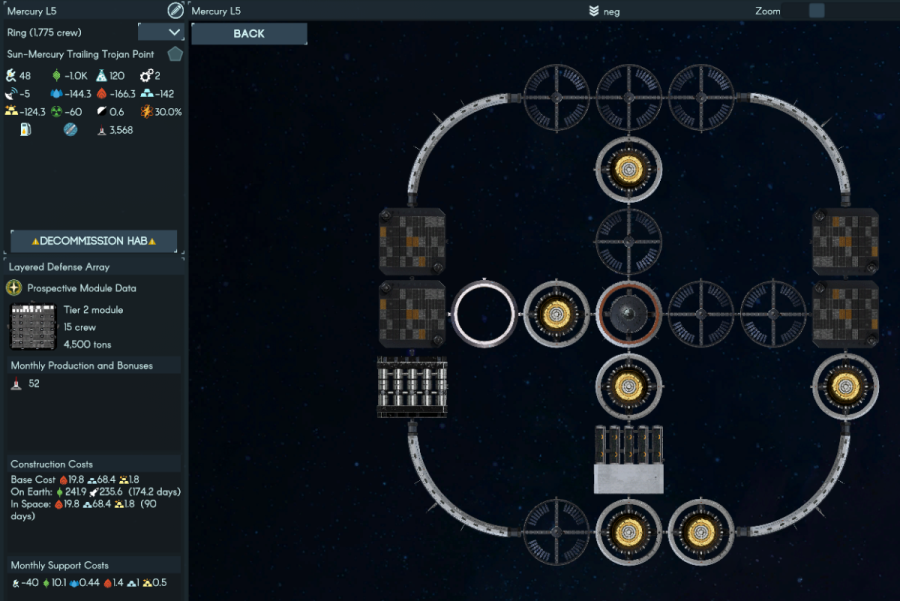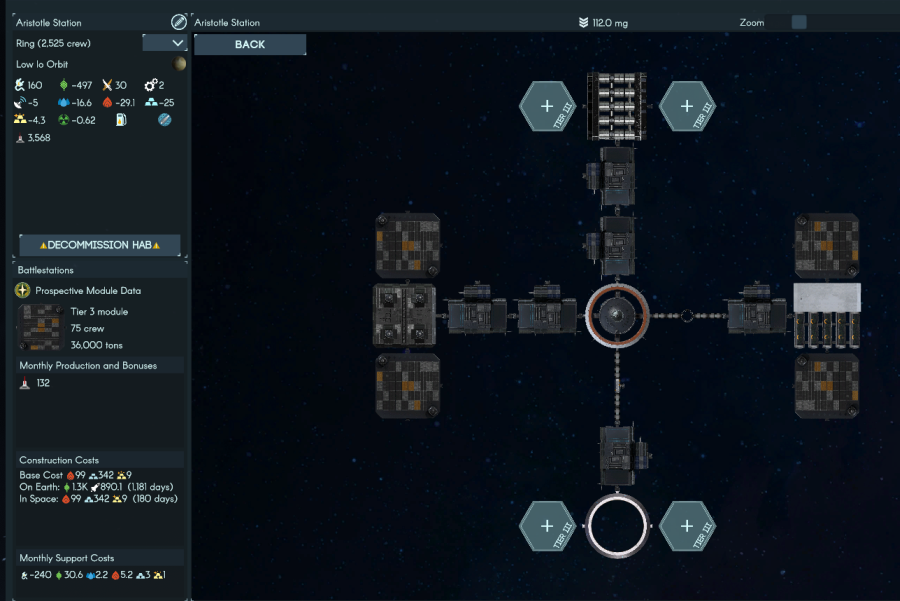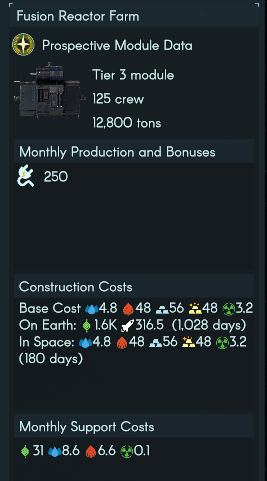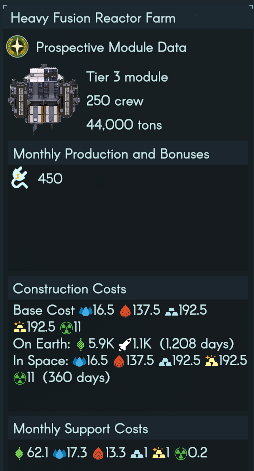Some Basic Suggestions on how to build useful/strong space stations.
Earth Playstyle
Something to remember is that you’ll likely have a LOT of bases but relatively few stations.
The levels for bases are Outpost/Settlement/Colony and the levels for stations are Platform/Orbital/Ring. When the game refers to a “hab” it is non-specific as to whether it is referring to a base or a station, but is rather a generic term that could refer to either/both. The main purpose of bases is to gather resources, and the main purpose of stations is to build/repair/refuel ships and to generate antimatter.
When playing the Earth phase, I build up both funding and mission control over time. Ships require money as maintenance (funding) and I use the mission control (MC) as an inefficient form of funding and research, an unused MC is converted to both money and research at an inefficient rate. You will want a lot of MC regardless.
In my play style my first drive/reactor combination that I shoot for Neutron Flux Torch and the Salt Water Core Reactor II. This is a pretty fantastic combo with only one caveat – it will burn your fissiles as fuel pretty darn quick. It does perform as well as most of the later engines and you can easily crank 600 dv for your ships. I use them for the Earth-Luna-Mercury-Mars region only, due to the refueling cost. It will let you capture escaping alien ships, however, so pretty useful. You will not want to run enormous fleets with these, by any means. I am a fan of using the Antimatter Spiker to make these engines more efficient.
The next set of drive/reactor combo I go for is the Advanced Antimatter Plasma Core Drive and the Antimatter Plasma Core Reactor. These run on antimatter and are far more fuel efficient. A little worse for the Cruise Acceleration but more than sufficient. I generally move up to 800+ dv with these engines. Here you can use both the Antimatter Spiker and the Hydron Trap.
The drive/engine/utility combination I just described uses small amounts of exotics in addition to small/reasonable amounts of antimatter. Don’t try to use Exotic/Hybrid armour or your exotics in weapon systems and you’ll have plenty to make your ships go.
Station Construction
I strongly encourage you to read up on Langrange points if you’re not already informed, as they are super awesome and amazing. There are typically 5 when a small body orbits a sufficiently larger body. (i.e. for twin star systems of equal mass, this doesn’t apply.) The first two, L1 and L2 are like a gravitation hill, and require station keeping to stay in place (not implemented in the game) but otherwise the gravitation forces balance out. For L3, L4, L5, it is like a gravitation gulley where you need to exert force to get out of, and as a result these tend to gather natural objects (also not implemented, as these orbits have no natural bodies, and also negligible gravity to escape).
As a strategy for station placement, I’m going to strongly encourage the use of Langrage orbits instead of planetary orbits, generally the L3/L4/L5 points.
Construction modules are currently a bit broken. If you have a construction module under construction, and other modules as well, when the construction module completes it will not move the completion date of the other modules up. That means you have to wait for construction modules to complete prior to initiating construction if you want to benefit from it.
The other difference is that the description / flavour text indicates that the construction module only affects modules of the same tier or lower as itself. This is not true, and the T1 construction module provides a 10% speed boost to the construction of T2 and T3 modules as well.
When you initially construct a platform and you get a construction module started for free, leave it there for when you’re building higher tier modules, otherwise decommission it. I anticipate how these modules work to be patched at some point, so this section should become obsolete at some point.
There are a couple of random events where people want to come tour your stations. It is imperative you keep a Skunkworks or Foundry on every station. Having a project/operations slot opened by those modules unlocks an option during this event which provides a permanent 5% increase to space mining and a permanent 5% increase to the speed at which ships are constructed. This is by far the best option and completely overpowered. This provides you with additional resources without any additional overhead costs, and this benefit cannot be taken away by the aliens or lost in any way. In addition, there are relatively few options to speed construction of ships and this is a zero overhead, zero maintenance, zero effort option. I can’t recommend it highly enough.
Generally you won’t want to use the Mercury orbit as your major shipbuilding area, as it is a waste of dv to constantly fly them to Earth or into the outer reaches of the solar system. The station is pretty well defended with 4 Battlestations. To augment the defenses, build ships with relatively low dv but high armour that are assigned to sit at your stations and defend them. This generally won’t be necessary, but remains open as a strategy.
Here is an image of an effect Mercury station that produces antimatter:

The modules are:
Solar Farm x7
Supercollider x6
Battlestations x4
Agricultural Complex x1
Foundry x1
Spaceworks x1
This station produces 0.6 antimatter per month, which is its primary function. You can also build/refit/refuel ships here, should you have to fight aliens in the area of Mercury. Mercury is a small orbit so it is pretty easy to blitz back and forth. This station coincidentally provides a 30% bonus to Energy research, for all the Fission/Fusion you need to research to get the end game drives.
I will strongly encourage an Agricultural Complex on every station and base. It produces 875 Water and Volatiles (each) per month and is a significant sources of resource production. It is also the only way to produce any of the 5 base space resources on a station.
Earth-Luna (Cheap Solar – Interface)
The Earth-Luna system is unique in that it allows for some modules which cannot be built anywhere else. Some of these modules give extra benefit above Earth when in an interface orbit.
Money (Earth-Luna)
Space Hospital / Geriatrics Facility
Tourist Berth / Space Hotel / Space Resort
Nanofacturing Complex (Anywhere)
Interface Only:
Influence:
Broadcast Outlet / Communications Hub / Media Center
Misc Bonuses:
Social Science Institute – Gives a bonus to Public Campaign when in Interface
XenoScience Institute – Alien Detection on Earth
Military Science Institute – Miltech
Planetary Priorities:
Nanofacturing Complex – Economy
Life Science Institute – Welfare
Information Science Institute – Knowledge
Media Center – Unity
Materials Institute – Military
Energy Institute – Boost
Space Science Institute – Mission Control
I generally do not recommend to build any of these (unless you specifically need to) with the exception of the Space Resort. It is very cheap upkeep and provides 250 Money every month, which is the same as for the Geriatric Facility and the Nanofacturing Complex, except with much lower upkeep. Note that you only receive funds from the Nanofacturing Complex once everything is completed building, however since it takes a year to build, it is usually the last thing anyway…
The Earth orbit is where you get parity between the Solar Farm and the Fission Reactor Farm, both 125 energy production. The Fusion Reactor Farm produces 250, but that isn’t necessary for our purposes.
Generally you will want to use the Earth-Luna system as your major shipbuilding area, as it is close to Earth in terms of dv and time, and that is where many of your conflicts with aliens will take place early on. As in the previous section, to augment the defenses, build ships with relatively low dv but high armour that are assigned to sit at your stations and defend them. This generally won’t be necessary, but remains open as a strategy.
Here is an image of an effect Luna station:

The modules are:
Solar Farm x12
Battlestations x4
Agricultural Complex x1
Foundry x1
Spaceworks x1
Space Resort x1
The primary function of this station is to build ships, be secure from alien threat, and cost little to upkeep. As you can see, it costs relatively little to maintain compares to other stations, costing only 85 Money, 0 Water, and 0 Volatiles. This is largely attributable to the Agricultural Complex, as previously mentioned:
I will strongly encourage an Agricultural Complex on every station and base. It produces 875 Water and Volatiles (each) per month and is a significant sources of resource production. It is also the only way to produce any of the 5 base space resources on a station.
As per the first section, there are unique benefits that can be wrought by building in an Earth interface orbit, and as previously stated, I don’t bother with them. Your primary goal will be to completely dominate all Earth orbits and keep them clear of aliens. Building a heavily fortified station in a LEO will ensure you always have a foothold on space. However, this is one of the areas that could be worth exploring. You will need to balance number of stations, defense, upkeep, and research bonuses.
Post-Earth Stations (Going Nuclear)
Beyond the Earth orbit is where solar panels become useless, and you’re forced to use either Fission or Fusion power. You will likely need to build resource generating bases, and in doing so, will attract the attention of the aliens. Therefore you’ll likely need to pick a system, such as the Jovian system, and build a variety of bases on Io, Europa, Ganymede, and Callisto. You’ll see that the resources there not only cover all 5 base space resources, and in far greater quantity than on Mars, but are all trapped within Jupiter’s gravity well. You’ll need a base to resupply and repair.
Here is an image of an effective Jovian station:

The modules are:
Construction Module x1 (not shown)
Fission/Fusion Pile x1
Fusion Reactor Farm x6
Battlestations x4
Agricultural Complex x1
Foundry x1
Spaceworks x1
Marine Battalion Barracks x1 (optional/wasteful)
Space Dock x1
So the strategy here is a little different. Since we’re starting to get farther from Earth, the time it takes to build a station in space goes up by the travel time. What we’re going to do is create a corvette with either a Fission or Fusion platform kit, and build it that way. That gives us the platform core, the Fis/Fus Pile, and the Construction module. If we have a Fusion Pile, it should produce 20 power, enough to power both the Construction Module and the Space Dock. Add a Space Dock if your fleet needs to refuel (30 days, build in space).
As soon as the Platform Core is complete, we’ll dive in and drag the Ring Core right on top of it. Do not right-click and upgrade the Platform Core, since that’s a waste of time.
As soon as the Ring Core is complete, we’ll slap down the T3 modules that we want. Note that the construction module should be complete by then, giving a 10% bonus to construction speed for all modules that start building after it is complete. (Even T3, subject to change.)
The primary function of this station is to build/refuel/repair ships, be secure from alien threat, and cost little to upkeep. As you can see, we’re keeping with our Agricultural Complex strategy. Since the upkeep on the Fusion Reactor Farm is 31 Money, 8.6 Water, 6.6 Volatiles, and 0.1 Fissiles, we can reduce that to just the Money/Fissiles portion. What we want to avoid is using the Heavy Fusion Reactor Farm, since it has an upkeep that also includes Metals and Noble Metals, and with double the Money/Fissile cost.
Take a look at the Monthly Support Costs:


Feel free to add a second Agricultural Complex, a Fusion Reactor Farm to Support it, and a Command Center to mitigate some of the MC requirement. This should make the upkeep a little more manageable depending on where you’re at with Mission Control. Just remember the CC takes 360 days to build.
In addition, the station pictures has both a Space Dock (the original one) and a Spaceworks. This allows it to refit 2 ships simultaneously. There doesn’t seem to be a huge need to refit ships (and sometimes it’s more logical to scrap them) so this may not be a strategy you’re interested in.
Bases
I intend to add more about constructing useful bases but need some of my current construction to complete to get good screenshots.
In the interim, here are some basics:
Bases are your source of space materials and are incredibly important to staying relevant in space. In theory you can send materials from Earth by spending Money and Boost, but in practice that hab will be destroyed long before the supplies get there and construction/defenses complete unless you are babysitting it forever with a fleet. Don’t get in that position. That also means ensuring none of your space resources ever hit zero.
Are the aliens interested in you yet? You will need to complete these projects:
Strategic Deception
Maskirovka
Operational Misdirection
They may be slightly different for your faction and can be locked behind some storyline projects as well. You can find them by going to the Full Tech Tree, checking Full Search, and typing, “construction by 25%”
If you are keeping the alien interest in your low, you can use automated outposts to mine. While I generally like this as a fire-and-forget strategy, the outposts can never be upgraded and you cannot build space defenses there. It is not a bad idea to throw them down on Mercury, where there are relatively few resources, it’s not far from Earth, and construction costs are higher. When you lose it in the later game, it won’t harm you that much, as you’ll moved on to major installations by the time you are triggering major alien interest.
When you have a location that is rich in resources and far from Earth, you will want to build an inhabited outpost for a couple reasons. One is that you can fortify it and not have to have a fleet nearby to defend it. Another reason is that the T3 ‘Colony Mining Complex’ extracts a lot more resources than the Automated or basic outpost mining complex, as it applies a multiplier to the base resources.
A level 3 base is a Colony, and will require 5 MC for the colony core and 3 MC for the mining complex. A total of 8 MC is quite the drag, so consider adding a Command Center to reduce that by 2.
Similar to the station strategy, focus on using Fusion Reactor Farms with an Agricultural Complex to reduce the Colony upkeep as much as possible.
You will want to build Battlestations. I have yet to have aliens land marines on any of my Colonies, but I do generally have a Marine Barracks there just in case (since I already have agriculture and the power cost is low). Consider building Battlestations x3 and Layered Defense Array x3, or a similar combination. You’ll find that the alien fleets attempt to bombard, but by the time they’ve destroyed one defense installation, the others have destroyed their fleet. This allows you to reconstruct your defenses without losing your base entirely.
More Guides:
- Terra Invicta: Factions & Alignment
- Terra Invicta: World Unification Guide
- Terra Invicta: How to Upload a Mod
- Terra Invicta: How to See What Options are Available for Your Country Policies without Wasting a Turn
